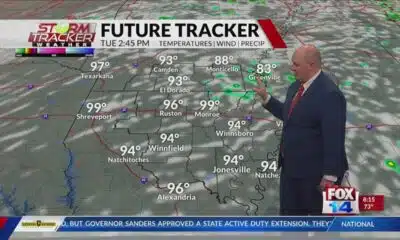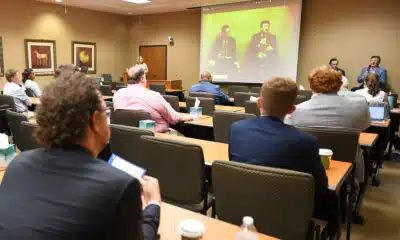News from the South - Arkansas News Feed
Arkansas town hit hard by tornado making progress
by Ainsley Platt, Arkansas Advocate
March 31, 2025
Cave City was quiet last week.
The day after a high-end EF-3 tornado ripped through the small Sharp County town with 165-mile-per-hour winds on March 14, the main stretch had been abuzz with volunteers, heavy machinery and people sifting through what remained of their homes, businesses and storage units.
Fifteen tornadoes touched down in Arkansas during the March 14-15 severe weather event, according to the National Weather Service. Three people were killed in neighboring Independence County by the same tornado that devastated Cave City. That tornado was also the longest-tracked tornado in Arkansas since 2008, according to the weather service, remaining on the ground for over 80 miles — something the service noted as being “exceptionally rare” for a tornado in Arkansas.
Fast forward a week and a half, and the atmosphere in town has changed. Power lines no longer litter the sidewalk on one side of Main Street. People weren’t slowing in their cars, gawking and taking videos on their phones as they drove past the destruction. Cell service had been restored, even if it was somewhat spotty.
The cleanup had made remarkable progress, even after a week that began with a tornado and continued with whipping winds and fires that burned homes in an already-devastated area.
The remains of the town’s pharmacy — totalled by the tornado — are gone. Only a concrete pad and a small pile of rubble remain. The church and the grocery store are surrounded by fences, their roofs covered with tarps and sheet metal to keep out future rain. An excavator began tearing into a brick house next door to the grocery store, pulling down what remained of its roof.
Other than people operating heavy machinery — clearing debris and trees — not many people were walking around.
Irma Carrigan, who runs the Crystal River Cave Tours and Motel, said the day after the storm that she wasn’t convinced the hordes of volunteers and support that arrived in town after the storm would last. But on Wednesday, a week and a half after the tornado that totaled her car and pulled down a massive tree in her yard, crushing one of the many small buildings on her property, Carrigan said she’d been pleasantly surprised by just how much people wanted to help, noting that she hadn’t heard one complaint from those who had arrived to offer assistance.
“It has all been very positive, very caring people,” Carrington said. “They set up food centers for different places. We didn’t have to cook during all of that.”
“The volunteerism is just phenomenal,” Carrington said. Still, sometimes it could be overwhelming, she noted, being asked by volunteers how to help when those impacted themselves still weren’t sure.
“You just look ignorant to them because you’re just saying, ‘I don’t know,’” Carrington said.
The waves of volunteers ebbed about five days after the storm, Carrigan reported, but she was grateful for the help she got. A nonprofit brought in a crane, cut up the huge tree into chunks, and helped haul it onto a family friend’s truck. Some roofers reattached a part from her roof that had blown off in the storm.
Still, other things have been slow coming. Carrigan said that as of Wednesday, they were still being told they had to boil their water. Their internet only returned two days prior, and cell service wasn’t always reliable.
In the aftermath of the storm, sleep was sometimes hard to come by.
“Your brain won’t turn off,” Carrigan said. “I think mentally, you can’t shut it off. You’re still thinking, ‘What am I going to be doing tomorrow? What can I do?’ You just continue to pray that you’ll get guidance and where you need to go next.”
Walking down one of the roads that branched off from Main Street, Carrigan pointed to her neighbors’ houses. The white, two-story, former boarding house next to hers was the oldest in town, she said, and one of its occupants was on hospice. It was badly damaged.
Next door to it was a smaller house, the back of it torn open. Those neighbors, Carrigan said, were trapped under the rubble of their home for hours after the tornado hit. One of them was over 90 years old. She said she’d heard that the property had already been sold to someone else.
The yellow house even farther down was occupied by another elderly neighbor in their 90s, Carrigan reported. They planned to repair the damage, she’d heard.
Another neighbor will tear down and put in a mobile home, Carrigan said. Yet another told Carrigan they were considering a modular home.
“He said, ‘I’m too old to build. I’m too old to rebuild,’” Carrigan said of the neighbor who was considering a mobile home. “And he said, ‘I want something; I don’t want to wait two or three years to get it.’”
Some people were scared to even clean their windows until their insurance appraisers showed up, Carrigan said, leaving some in a state of limbo.
Carrigan expressed support for a federal disaster declaration, which Gov. Sarah Huckabee Sanders requested last week. Sander asked for additional federal help over the weekend.
“I would think they would,” Carrigan said of the federal government helping with disaster recovery. “I mean, I can’t imagine a disaster any worse.”
However, the Federal Emergency Management Agency, which normally manages federal disaster responses, is in the crosshairs of the Trump administration as one of its targets to be shut down, with the Washington Post reporting that Department of Homeland Security Secretary Kristi Noem expressed support for removing FEMA’s role in recovering from disasters by October.
It’s unclear how such an action would impact a federal disaster response in Arkansas if the declaration is approved. Stateline reported last month that disaster experts and states have said that they aren’t able to take on the role FEMA currently fills.
Carrigan wasn’t the only one who would like to see the disaster declaration approved. Brandi Schulz, the executive director of the Cave City Area Chamber of Commerce, said the money that would be available to both businesses and residents would help with the recovery.
“From a chamber director perspective, I know that (a federal disaster declaration) would open up some options for our businesses that were impacted,” Schulz said. “I know that there were going to be more options, supplemental options, outside of insurance if that does go through, so in that regard, I am hoping that we can get more assistance to our businesses and also to our residents.”
Schulz described Cave City as a “very DIY community,” and said that it, combined with the support of volunteers and donors, meant that the city would likely be in “a very good place” on debris removal within the next week. Roughly 59 people have been displaced by the tornado in the area, Schulz estimated.
Taking care of the physical needs of those who were affected doesn’t just mean helping clear debris, however. Schulz said the wife of the town’s fire chief, whom the chamber director said “specializes in trauma debriefing,” has been offering resources for the community.
“I think the biggest thing is people knowing that they’re not alone, that we’re here for them,” Schulz said. “And I think we’ve shown that in the last week or so.”
Carrigan expressed some frustration with communication from state and local authorities, even as she said she appreciated what they were doing and was satisfied with the rate at which cleanup and recovery had been happening. She heard that state money was available to those impacted to help with storm recovery, but wasn’t able to figure out how to apply. She said the Red Cross opened a shelter, only to close it 48 hours later.
“I went up to the Assembly of God to check out, try to find this Red Cross and they said, ‘Well, they were here, but nobody came up here to use their services,’” Carrigan said. “And I said, ‘Well, honey, nobody knew that they were here.’”
Schulz said local officials made efforts to reach people who weren’t able to get online information, at one point distributing fliers, she said.
The Red Cross confirmed it closed the shelter due to lack of use.
“We had some families that expressed interest, and then had found other places to say,” Red Cross regional spokesperson Sharon Watson said, adding that they had been coordinating with local faith leaders and town officials to get the word out. “Some had requested hotels, and we didn’t have hotel vouchers to offer because we had a shelter set up, and our shelter was available so therefore they opted to find other places to stay, which we completely understand.”
Watson noted that the shelter wasn’t the only way it was helping the community. On Thursday, the Red Cross opened several “Multi-Agency Resource Centers” in conjunction with the Arkansas Voluntary Organizations Active in Disaster for those affected by the tornado outbreak, designed to serve as a “one-stop shop” for residents to get answers from state and local authorities about disaster assistance.
The MARCs were open from Thursday to Sunday in different cities — Diaz on Thursday, Cave City on Friday, Melbourne on Saturday, and Pocahontas on Sunday.
Meanwhile, management of volunteers and donations was handed over to Eight Days of Hope, a Christian nonprofit, after being managed by local officials such as Schulz.
Gale Manning, the rapid response manager for the Cave City relief efforts, said the organization will be on the ground until April 5. Volunteers have been helping cut up and haul off trees, he said, to help make the area safer. He said roughly 70 to 80 people had been volunteering on the weekdays, with volunteers coming from as far away as Alaska.
“They’re devastated,” Manning said of the people who had been impacted by the storm. “They’ve lost their life savings, belongings. But, you know, as the days go on, they feel a bit better. Again, we share the gospel and we let them know that God’s in control and that he knows what’s going on, and he promised us all a better day.”
Arkansas Advocate is part of States Newsroom, a nonprofit news network supported by grants and a coalition of donors as a 501c(3) public charity. Arkansas Advocate maintains editorial independence. Contact Editor Sonny Albarado for questions: info@arkansasadvocate.com.
The post Arkansas town hit hard by tornado making progress appeared first on arkansasadvocate.com
News from the South - Arkansas News Feed
Bentonville police search for possibly armed man on Crystal Bridges trails
SUMMARY: Bentonville police are investigating reports of a possibly armed man seen on Crystal Bridges trails around noon today. Authorities conducted an extensive search on foot and with drones but did not find anyone. At the time, several areas of Crystal Bridges were restricted to the public, but officials confirmed there is no ongoing danger now. The venue is currently closed as a precaution, prioritizing the safety of members and guests. News teams are seeking more information from local law enforcement and Crystal Bridges, but no further updates have been provided yet. The situation remains under active investigation.
Bentonville police searching for possible armed man
Subscribe to 40/29 on YouTube now for more: http://bit.ly/PTElbK
Get more Northwest Arkansas news: http://www.4029tv.com
Like us: http://facebook.com/4029news
Follow us: http://twitter.com/4029news
Instagram: https://www.instagram.com/4029news/
News from the South - Arkansas News Feed
Congress, state lawmakers move to juice aviation biofuel production
by Allison Prang, Arkansas Advocate
July 13, 2025
Congress’ passage of President Donald Trump’s spending and tax cuts bill this month could help grow the market for sustainable aviation fuel, a nascent industry that could be a boon for corn-producing states as airline operators are betting on it to decarbonize the sector.
The Republican budget reconciliation law that Trump signed July 4 pared back some of the credits for sustainable energy in the law that congressional Democrats passed and President Joe Biden signed in 2022 — the Inflation Reduction Act.
But the recent law extended one energy tax credit for producing clean fuels, such as sustainable aviation fuel, an alternative to the typical jet fuel planes use. The credit initially went through 2027, but the GOP law extends it through 2029.
Advocates for sustainable aviation fuel had been pushing Congress to extend the tax credit to support production as states across the U.S. have passed or proposed their own tax credits to grow the sector and lure production within their borders. Lawmakers in Iowa, Wisconsin, Michigan and New York have introduced bills enacting tax credits for sustainable aviation fuel.
For airlines, increasing availability of the fuel is essential for the sector to meet its net-zero goal for 2050, with the International Air Transport Association estimating the cleaner fuel could get the industry 65% of the way toward its target.
“We’re not yet at commercial-scale production and you need that longer lead time for these types of projects so I think the extension is really key,” said Chris Bliley, senior vice president of regulatory affairs at Growth Energy, a biofuel industry group.
While the credit’s lifetime was extended, others say the environment for sustainable aviation fuel isn’t as favorable as it was just a few years ago. The new budget reconciliation law also included provisions to lower the credit amount for sustainable aviation fuel specifically and clawed back unobligated grant funding to support the sector.
The amount of sustainable aviation fuel that producers make today is far from how much the airline industry needs to be able to use the alternative fuel regularly. U.S. production capacity over the last couple of years, however, has grown, jumping from less than 5,000 barrels per day at the start of 2024 to more than 30,000 by February of this year, according to a May report from the U.S. Energy Information Administration.
Badger State bill
Wisconsin state Rep. David Steffen, a Republican who sponsored a bill to incentivize sustainable aviation fuel, said he learned about a sustainable aviation fuel production company based in Madison called Virent Inc., now a subsidiary of Marathon Petroleum Corp. Virent’s fuel helped power the first domestic flight powered by 100% sustainable aviation fuel in one of its engines.
“I was intrigued that we had this company in our state and I want them and other companies of similar interest to find Wisconsin as their new home,” Steffen said. “It’s a great opportunity for not only the environmental benefits that come with it but for our farmers, dairies and timber producers to access a brand-new market for their product.”
Steffen’s bill also requires that to receive the tax credit, source materials for the fuel must be domestically sourced.
Wisconsin’s legislative session doesn’t end until next March and Steffen said he’s “very comfortable in saying (the bill) will have a clear path to the finish line.” Should it pass in its current state, the tax credit would go into effect in 2028.
Other states
Iowa, Illinois, Minnesota, Nebraska and Washington state all already have enacted laws to provide tax credits for sustainable aviation fuel.
Lawmakers in New York and Michigan have also proposed legislation to create their own tax credits. The New York bill barely moved in the most recent session, while legislation in Michigan has made it out of one committee and been referred to a second.
New York state Sen. Rachel May, a Democrat, plans to re-introduce the legislation next year. She said she wants to amend her bill to offer a larger tax credit for companies making sustainable aviation fuel specifically by mimicking photosynthesis so it doesn’t incentivize diverting feedstock like corn from being used for food, she said.
Her concern is moving the agriculture industry “away from both food production and maybe what might be the best uses of the land,” she added.
Corn ethanol, a common ingredient in automotive fuel, can be used to make sustainable aviation fuel.
Federal extension
While the extension of the federal clean fuels tax credit could be beneficial to the sustainable aviation fuel industry, the new law also lowers the amount of the tax credit for the fuel. It’s now the equivalent to what other biofuel producers qualify for, giving sustainable aviation fuel production less of a competitive advantage.
One version of the budget reconciliation bill also called for extending the tax credit by four years instead of two, but that got scaled back in the version of the bill ultimately signed into law.
The new law also took away any funding not yet obligated as part of a grant program for sustainable aviation fuel and makes fuels derived from feedstocks that come from outside the U.S., Canada or Mexico ineligible for the tax credit.
Despite any limitations, some analysts expect the law will still boost sustainable aviation fuel.
“The Trump administration has yet to outline its approach to SAF, but we expect the fuel to benefit from the administration’s focus on supporting biofuel-producing states,” analysts for Capstone DC, a firm that advises business clients on policy issues, said in a note in late June.
But changes to the federal tax credit could also make states more interested in adopting their own credit to support sustainable aviation fuel, Capstone added.
‘Not nearly as strong’
Tariffs, meanwhile, could also make U.S. feedstocks for producing the fuel more competitive, Paul Greenough, a vice president on Capstone’s energy team.
But Greenough cautioned that sentiment around sustainable aviation fuel still isn’t as rosy as it used to be.
“Momentum still exists for SAF but it’s not nearly as strong as it was under the Biden administration,” he said.
Some climate groups have also expressed concern over changing the clean fuels tax credit at the federal level. The Clean Air Task Force, ahead of the bill becoming law, said extending the credit will largely service other fuels that aren’t sustainable aviation fuel, which will in turn be costlier for the government.
“This purported attempt to incentivize ‘clean fuels’ is little more than a giveaway to the conventional biofuels industry,” the organization said in a post on its website.
Arkansas Advocate is part of States Newsroom, a nonprofit news network supported by grants and a coalition of donors as a 501c(3) public charity. Arkansas Advocate maintains editorial independence. Contact Editor Sonny Albarado for questions: info@arkansasadvocate.com.
The post Congress, state lawmakers move to juice aviation biofuel production appeared first on arkansasadvocate.com
Note: The following A.I. based commentary is not part of the original article, reproduced above, but is offered in the hopes that it will promote greater media literacy and critical thinking, by making any potential bias more visible to the reader –Staff Editor.
Political Bias Rating: Center-Right
This article presents a mostly factual overview of recent legislative actions concerning sustainable aviation fuel (SAF), with a focus on the bipartisan but GOP-led budget reconciliation bill signed by former President Donald Trump. The tone is generally neutral but leans slightly toward a center-right perspective by emphasizing the Trump administration’s role in extending energy tax credits and highlighting support from Republican lawmakers. It also includes critical views from climate groups and notes Democratic legislative efforts, maintaining a balanced presentation. The framing subtly favors market-driven, industry-supported solutions aligned with conservative energy policy approaches, rather than expansive environmental regulation favored by the left.
News from the South - Arkansas News Feed
Man shot and killed in Benton County, near Rogers
SUMMARY: A man was shot and killed late last night in the Beaver Shores neighborhood near Rogers in Benton County. Police identified the victim as 41-year-old Kevin Nikel, who was shot in the abdomen and later died at the hospital. Neighbors described the area as usually peaceful and quiet, expressing shock and concern over the incident. Authorities have not disclosed what led to the shooting or if there are any suspects. The Benton County Sheriff’s Office declined to provide an on-camera interview. Residents say the tragic event has changed the neighborhood’s atmosphere, making them more cautious and uneasy.
Man shot and killed in Benton County, near Rogers
Subscribe to 40/29 on YouTube now for more: http://bit.ly/PTElbK
Get more Northwest Arkansas news: http://www.4029tv.com
Like us: http://facebook.com/4029news
Follow us: http://twitter.com/4029news
Instagram: https://www.instagram.com/4029news/
-
News from the South - North Carolina News Feed6 days ago
Learning loss after Helene in Western NC school districts
-
News from the South - Tennessee News Feed1 day ago
Bread sold at Walmart, Kroger stores in TN, KY recalled over undeclared tree nut
-
News from the South - Missouri News Feed6 days ago
Turns out, Medicaid was for us
-
Local News7 days ago
“Gulfport Rising” vision introduced to Gulfport School District which includes plan for on-site Football Field!
-
News from the South - Florida News Feed6 days ago
The Bayeux Tapestry will be displayed in the UK for the first time in nearly 1,000 years
-
News from the South - Louisiana News Feed7 days ago
With brand new members, Louisiana board votes to oust local lead public defenders
-
Mississippi Today4 days ago
Hospitals see danger in Medicaid spending cuts
-
News from the South - Arkansas News Feed6 days ago
Arkansas Department of Education creates searchable child care provider database












































